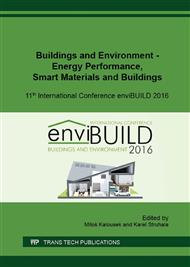p.287
p.295
p.303
p.311
p.320
p.327
p.335
p.343
p.353
Effect of the Moisture in the Heat Storage Capacity of Building Structures
Abstract:
Buildings in Europe, account for about 20–40% of total final energy consumption. Therefore reduction of energy demand is crucial. It has become one of the most important issues to achieve energy saving at installations and refurbishments of buildings. Humidity in the wall structure of buildings produced by precipitate and other circumstances could modify the building’s heat capacity, the heat transfer coefficient furthermore density and/or other factors. In this study, wall structures of buildings with nearly zero net energy consumption were examined that were built from different materials with different moisture load. By applying different experiments and calculations we presented the changes of the stored heat energy of different wall structures in relation to the duration of the wetting time. The external wall of the building is the interface between the interior of the building and the outdoor environment. From the perspective of sorption and heat capacity, knowledge of the behavior of structures in relation to their moisture content, can help us to select the perfect type of wall. We have found three major traits peculiar to the change in the stored heat of different building structures in relation to the moisture load.
Info:
Periodical:
Pages:
320-326
Citation:
Online since:
December 2016
Authors:
Keywords:
Price:
Сopyright:
© 2017 Trans Tech Publications Ltd. All Rights Reserved
Share:
Citation:


